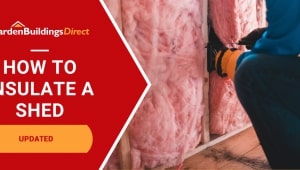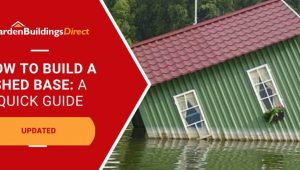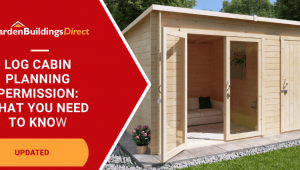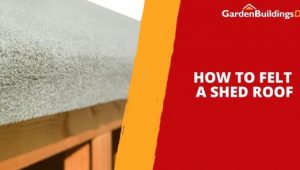Jump to:
Shed maintenance is essential to make sure your outdoor storage or workshop will be protected from weathering over not just winter but throughout the year. This shed maintenance guide will give you everything you need to get started.
Note: This advice generally applies to wooden sheds.
Shed Refurbishment Checklist
Refurbishing your shed is about getting it back into shape, and your to-do list could look like this:
- Repair and replace what’s worn out
- Sort out leaks
- Give it a fresh coat of paint
It could be a quick tidy-up or a bigger job if it’s been neglected for a while. But however much there is to do, this checklist will help you ensure you complete all of it.
Wooden shed repairs and refurbishments
Fixing up your shed can mean dealing with anything from rotten wood panels, loose boards, or rusty nails, which need replacing ASAP. For instance, cut out the damaged sections and fit new timber. Or swap corroded nails and put in new roofing tacks.
The door hinges could feel wobbly or show signs of corrosion, too. Inspect everything, along with the windows, and clean them up and tighten screws as needed. Damaged locks or handles may also need changing to keep your shed secure.
If your shed has a wooden floor, check these for any serious cracks or dents. Broken floorboards will need to be replaced for the integrity of the building. This can become a matter of safety but also for keeping out pests.
It helps if you take a proper look at your shed, so you know what work it needs. Then all you need to do is ensure you have the shed repair materials and tools to get the work done.
Fix shed leaks
These gaps where water gets in can appear on the ceiling, around windows and doors, and in joint panels. Common signs that they’ve taken hold in your shed include, but are not limited to:
- Gaps or cracks in or between the wall boards or the roof attachments
- Cracked or missing shingles, damaged felt, or holes in the roof
- Sealant worn away or cracks visible in the window and/or door frames
- Missing caulking on the joint panels
Get them fixed and don’t wait for them to become bigger issues!
Gaps in the wood can sometimes be patched with more wood, or use sealing caulk on smaller holes.
Roof felt and shingles can be pretty durable, but if your roof has taken a lot of wear and tear from the weather, it could have been damaged. Rather than try to patch a hole, it’s better to re-felt the shed roof and replace the affected section, or replace your broken shingles with new shed shingle tiles.
Give your shed a new coat of paint
Painting or staining your wooden shed is one of the most important maintenance jobs, to be done once a year. Towards the end of summer is the best time to do this, because:
- Your shed will have fresh protection ahead of the autumn and winter storm seasons.
- The weather should allow the coat to dry well.
- You get to do the job when the weather is nicer.
With a few strokes of your paintbrush (and the right paint colour), you can breathe new life into your shed. Not only does this improve how it looks, but it also helps protect the wood from weather damage.
Read our guide on How to Paint a Wooden Shed to take you further into this process.
For paint, choose an exterior wood type for durable, weatherproof coverage. Or try a wood stain to highlight the natural grain while still protecting your shed.
As long as it’s labelled for exterior use, both should cope well with the weather, rain or shine.
Ongoing Shed Maintenance
With your shed refurbishment completed, now you need to make sure your efforts don’t go to waste. Here are the maintenance tasks to keep up with:
- Inspect the roof regularly: Look for signs of wear, e.g. curling felt edges, slipped shingles, or debris.
- Touch up paint or stain: A fresh coat might not be needed straight away, but give it a once-over each year.
- Oil the hinges and locks: Stops them from stiffening up or rusting again.
- Ventilate: Open the doors or windows now and then to reduce condensation. Have a look at our guide on shed ventilation to learn more.
- Sweep and declutter: Not exciting, we know. But keeping the inside clean means less chance of damage from rot, pests, or trapped moisture.
- Check the base: Watch for signs of sagging, rot, or erosion around the foundation. A stable base means everything else holds up better and it means you can safely set up your shed on decking, too.
These are just a few ideas to get you going. What your shed needs might be different. Think of this as a starting point, and don’t hesitate to add your own based on how you use your space.
This guide has a few more tips that might help: The Must-Have Tools in Your Shed for Repair and Maintenance





